
The long road to convergence: How F1 closed the gaps of the hybrid era
Twelve years after Mercedes blew the field apart, we chart how F1 finally closed the gaps - and why the 2026 reset could reopen them
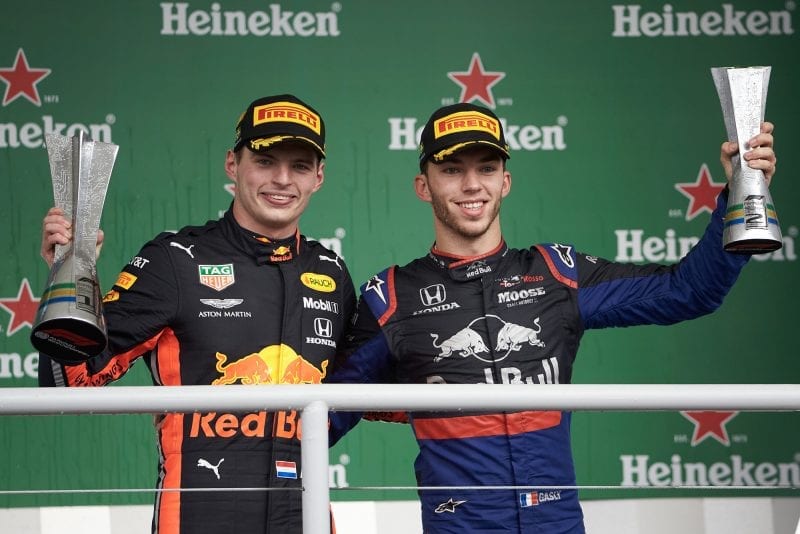
“This out-lap is crucial,” Lewis Hamilton was informed.
“You don’t need to tell me,” he replied with the tone of someone who knew he was up against it, trying to pull off a result against a faster car.
The faster car – decisively so all weekend – was the Red Bull-Honda of Max Verstappen. In this most typically and wonderfully random of Interlagos races, this was the brief moment when Hamilton may have been able to steal it.
It would have been a steal too – because the Mercedes just did not have the legs of the Red Bull-Honda all weekend. But Hamilton had got close enough to it by the 20th lap for Mercedes to stretch up to an undercut attempt.
Likely it was going to be doomed because Verstappen had a couple of seconds’ cushion and was sure to be super-quick on his in-lap, regardless of the speed of Hamilton’s out-lap. But as Verstappen encountered Robert Kubica’s Williams in the pitlane, that little window of opportunity opened for Hamilton, and he did get in front.
But in reality, the out-lap had used up electrical energy he couldn’t afford. It left him helpless to defend as Verstappen immediately put right the wrong.
But that was just the prelude to the really crazy stuff. A Honda 1-2, with Pierre Gasly’s Toro Rosso backing up Verstappen. The two Ferraris taking each other out. Alex Albon losing second place with just over a lap to go. Two late safety cars. Where to start?
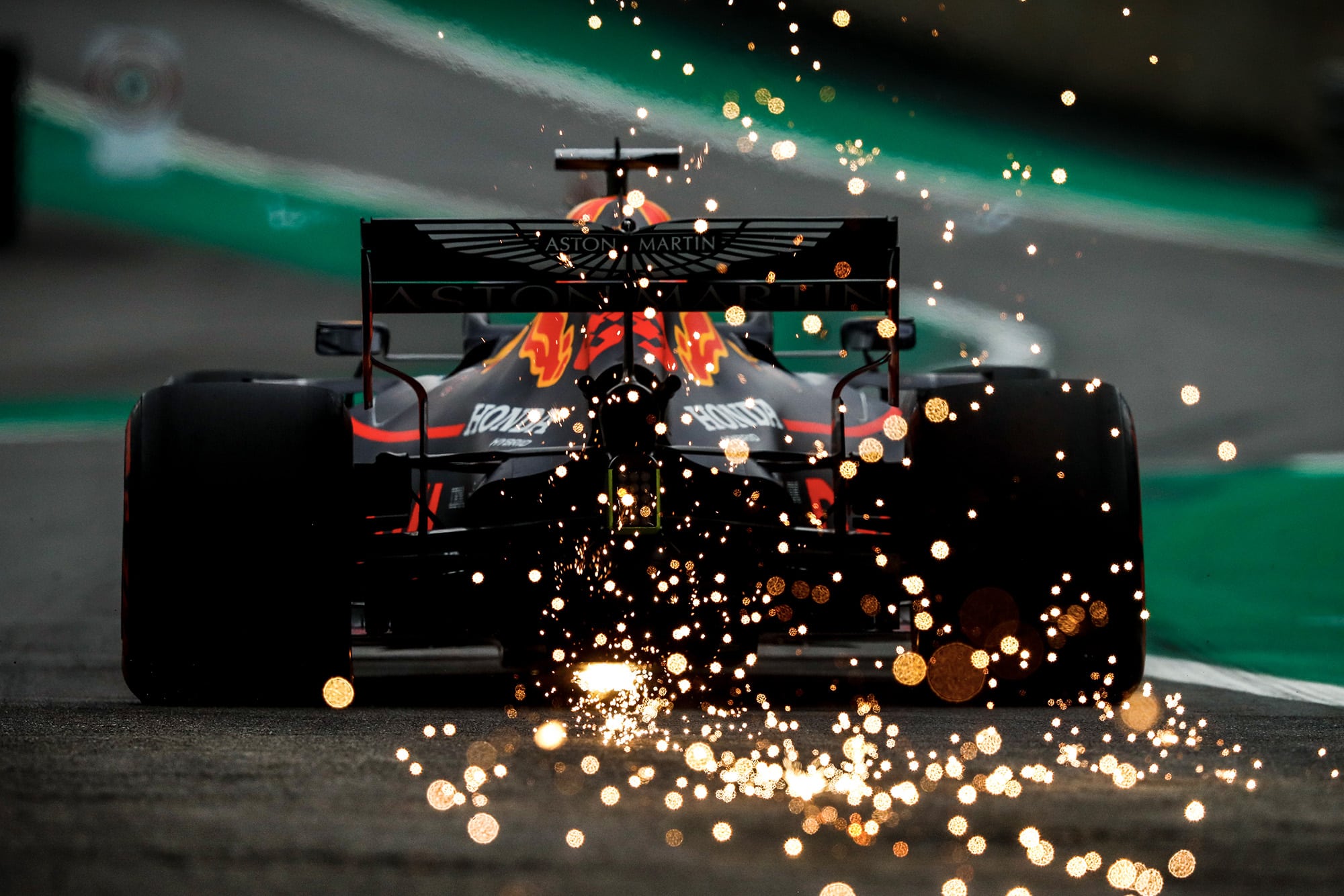
Verstappen during qualifying Photo: Motorsport Images
At 780 metres, Interlagos sits as the second-highest track on the calendar and, although the effects are nowhere near as dramatic as at the 2,400 metre-high Mexico City track, they are still felt. They are felt in particular by the Mercedes engine, which suffers a greater power loss than the Honda and Renault in particular. Ferrari, it seems, is somewhere in between.
So, rather like at Mexico, the combination of a chassis as good as the Red Bull RB15 with a small power advantage over Mercedes was enough to make Max Verstappen the fastest thing in the place – and this time he didn’t get himself penalised out of pole. He secured it by the margin of 0.13sec over Ferrari’s Sebastian Vettel – although until Charles Leclerc messed up his first Q3 run, he’d been on schedule to challenge Verstappen’s time.
The Ferrari, in other words, was still super-quick and it can be appreciated that its lack of pace on race day in Austin was not representative. Mercedes scratched third on the grid with a last-gasp quality lap from Lewis Hamilton but was a couple of tenths down on Verstappen around a short track. “We’re down on power here to them,” he said, referencing both Red Bull and Ferrari.
Verstappen’s final lap was hard and aggressive and a tenth faster than he’d managed on his first run, even though the track was becoming slower as the temperatures fell in the late afternoon. This was explained by his running too wide over the exit kerb of Turn Nine on his first attempt. “We had to do a bit of track adjustment for conditions,” he explained, “but it was generally good. When the track temperature became warmer [compared to P3] we got oversteer.”
Although hotter than the P3 session had been earlier in the day, the track temperature was falling through the session and it made getting the tyre temperature balance right particularly tricky for everyone.
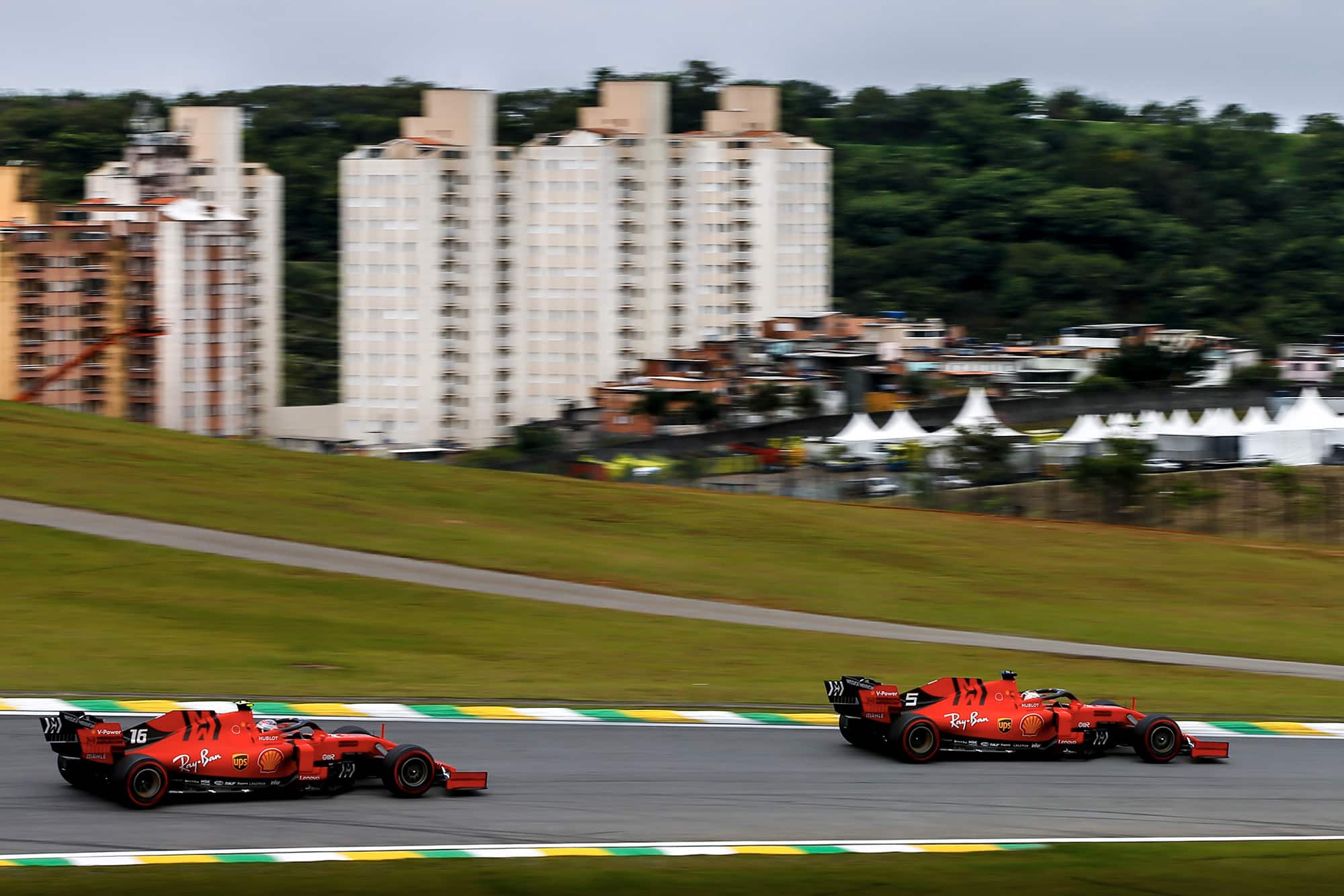
Leclerc qualified behind Vettel even before his penalty Photo: Motorsport Images
Vettel felt that Ferrari had done a particularly good job of anticipating the temperature changes as the car become progressively less understeery and more neutral. “It really came alive in Q3,” he said, “and that was how it was planned.” He felt his final lap was a good one but the Ferrari just didn’t quite have the legs of the Red Bull.
In the power-dominated third sector, Leclerc was marginally fastest, with Vettel losing a couple of hundredths to him there on account of running slightly more rear wing angle. The Red Bull was making its advantage through the downforce-dominated middle sector where it out-performed even the Mercedes. The Ferrari was losing out there and clawing it back through sectors one and three, by not quite enough over the Red Bull but sufficient to edge it clear of the Mercs.
Leclerc was taking a 10-place grid penalty for a new Spec 3 engine to replace the one damaged in practice at Austin. His fourth-fastest time, 0.1sec adrift of Vettel, came on the first Q3 run and included a mistake at Juncao, the last corner, which he reckoned cost 0.3sec. He’d been the only one to run the medium in Q2, giving him the option of a long first stint from his penalised grid position.
At Mercedes they’d been intrigued to note in P3 that morning that having Hamilton’s front tyres run cooler than planned resulted in his best lap time. Which, in turn, led them to follow that path in qualifying. It turned out to be the wrong direction, as James Allison noted. “We only reversed out of that on the final Q3 run,” he said. “If we’d been quicker to spot that, I think it’s possible we’d have made up a grid place.” As it was, Hamilton was relieved to even be third, having been up to 0.5sec off the pace in Q2.
Valtteri Bottas was 0.15sec down on Hamilton, fifth-fastest. “My first Q3 run was pretty decent, just lost a few hundredths on the entry to Turn Nine and I had the feeling I’d got pretty much everything out of it,” he said. “On the final run it was just sliding more everywhere. We were losing a lot of time up the hill. We just didn’t have a front-row car today.”
Alex Albon in sixth, 0.4sec down on Verstappen, was scratching a little. He’d had an off at the end of the wet first session after going fastest. Generally, he was finding the demands of the place a bit confusing. “I’m still chasing for that final bit. Yes, it’s my first time here but I don’t like that excuse, and I don’t want to make excuses in general. I think it’s quite a tricky track, with long corners and low speeds. It’s very thermal sensitive so if you make a little mistake in one corner, you pay the price in the following four or five corners. Even in my second run, I had a little snap into Turn Two and then the tyres are too hot for the rest of the lap.”
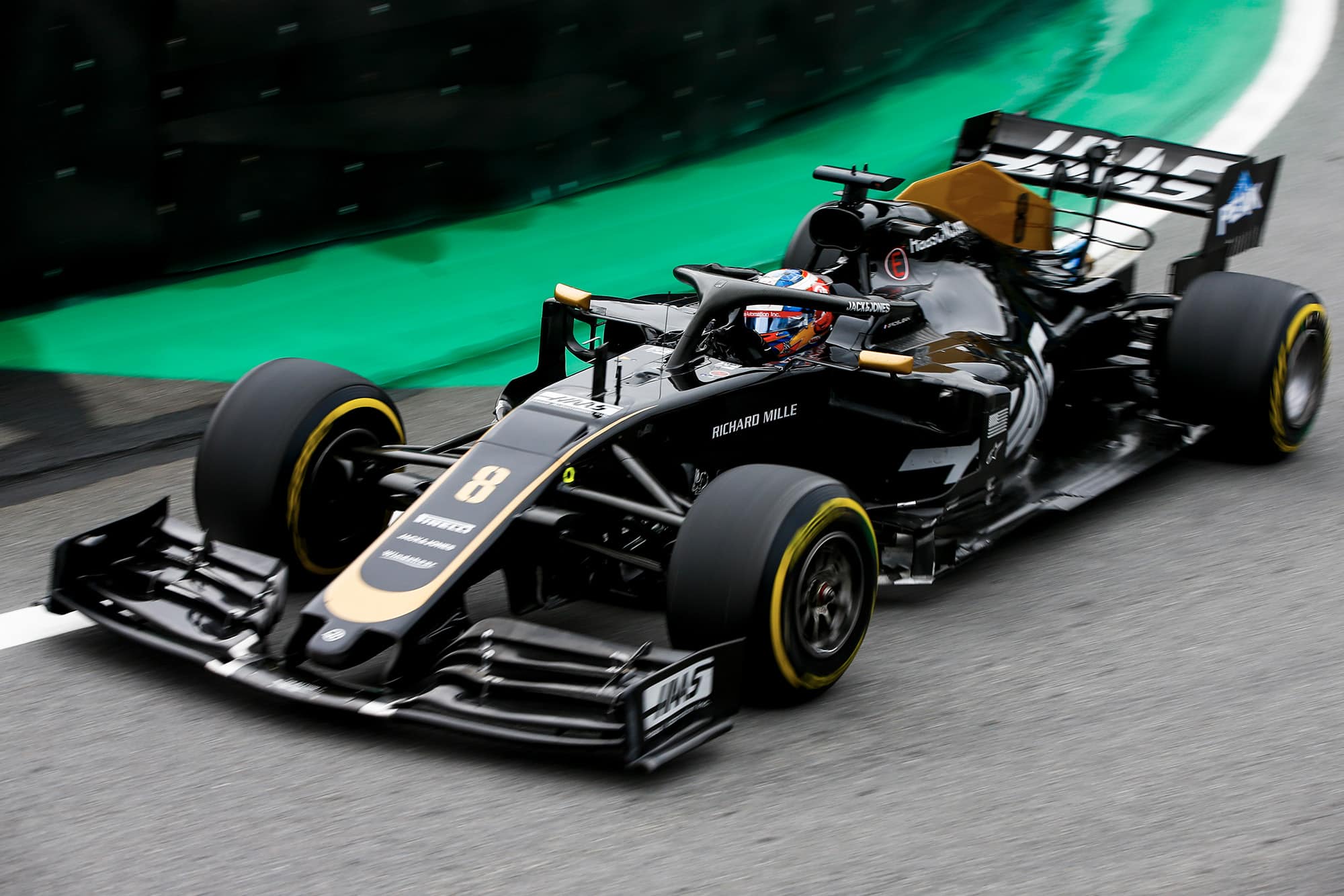
Haas surprised itself with qualifying pace Photo: Motorsport Images
Toro Rosso’s Pierre Gasly emerged as best of the rest, with a great seventh-fastest time, underlining – as in Mexico – the Honda’s strong performance. He and his engineer had been particularly attuned to the changes in the track and had made good on-the-fly calls in adjusting the car to suit. Team-mate Daniil Kvyat didn’t do so and failed to make it out of Q1, having been best of the rest in that morning’s practice.
Gasly only just pipped Haas’ Romain Grosjean to that ‘Class B’ pole. The team seems finally to have a working understanding of the rear end low-speed aero problem that has been causing the rear tyres to overheat. Grosjean and team-mate Kevin Magnussen (in 10th) were nonetheless taken aback by just how quick they were.
Kimi Räikkönen scraped his Alfa into Q3 and put it ninth there while Antonio Giovinazzi spun out of his final Q2 run, his first one good only for 13th. McLaren suffered a terrible qualifying. Carlos Sainz was left without a lap on the board after improperly secured wiring cut the Renault engine out as he hit a kerb.
Lando Norris just couldn’t quite scrape Q3 speed from the car and was only 11th. But this was a couple of tenths faster than Daniel Ricciardo’s Renault, with the sister car of Nico Hülkenberg a couple of places behind. Sergio Perez only just scraped the Racing Point into Q2, with Lance Stroll’s sister car 0.5sec slower back in 17th, behind Kvyat.
Williams brought up the rear a further 1sec adrift of Racing Point. George Russell was half-a-second faster than Robert Kubica who was in a fresh chassis after damaging his original with a big off on Friday afternoon after getting a tank-slapper over Turn Three kerbs made wet by Kevin Magnussen having been out on the grass there a few seconds previously.
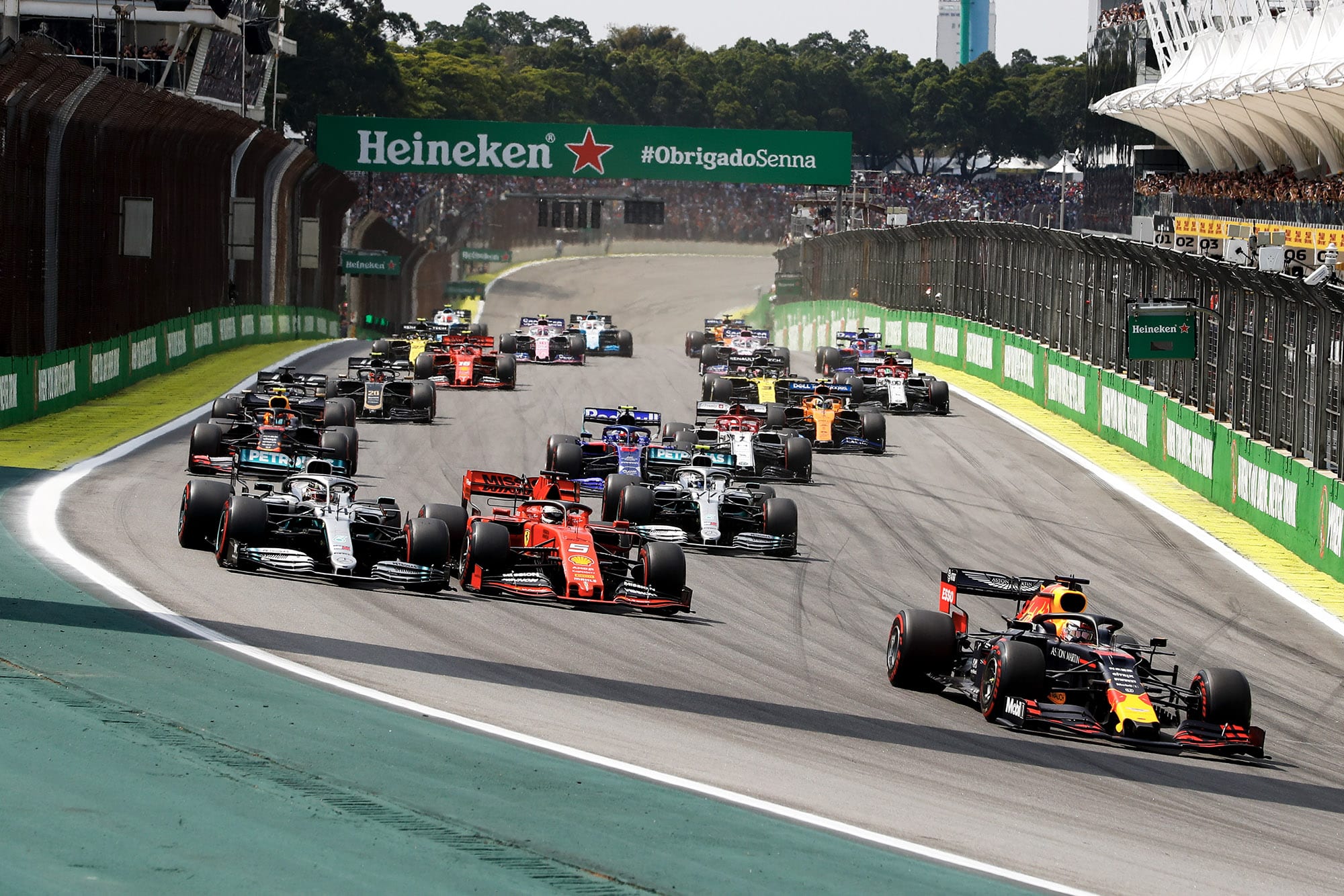
Verstappen holds onto his lead at the start Photo: Motorsport Images
The weekend’s first sunny day, the place a near sell-out, getting close to the vibe of its vintage days, track temperature creeping up to 48C. Which was going to saturate the performance from the tyres much more quickly than did the 24C of the Friday long runs, moving the likely optimum strategy to an open-minded two-stop (for this remains a black art) but with some combination of the soft and medium compounds likely, the hard being simply too slow regardless of temperature.
The gladiatorial amphitheatre had rarely looked better as the cars sat glinting in the sun, shimmering heat hazes from brakes and exhausts. As the gantry red lights went out, Verstappen burst out the blocks, unchallenged into the Senna Esses. That outside line offered up a lot more grip, helping Hamilton immediately out-drag Vettel from a row behind, Seb moving sharp right but too late to block him off, the Mercedes sailing around the Ferrari’s outside to slot into second, with Bottas and Albon soon putting distance on the head of the Gasly-led mid-pack, Grosjean, Räikkönen, Magnussen and Giovinazzi following on in that group.
In the hurly-burly of an Interlagos opening lap, Leclerc from 14th and Sainz from last were quickly picking off slower cars, Stroll weaved his way by team-mate Perez on the infield, Giovinazzi held off Norris on the exit of the Turn 10 hairpin, allowing Leclerc to get a run on the McLaren and all in a big hurry the pack rushed over the rise at crazy speeds, wheels scarily close, crowd cheering at the great festival of it all – as Verstappen pushed on, already over 1sec clear of Hamilton and Vettel.
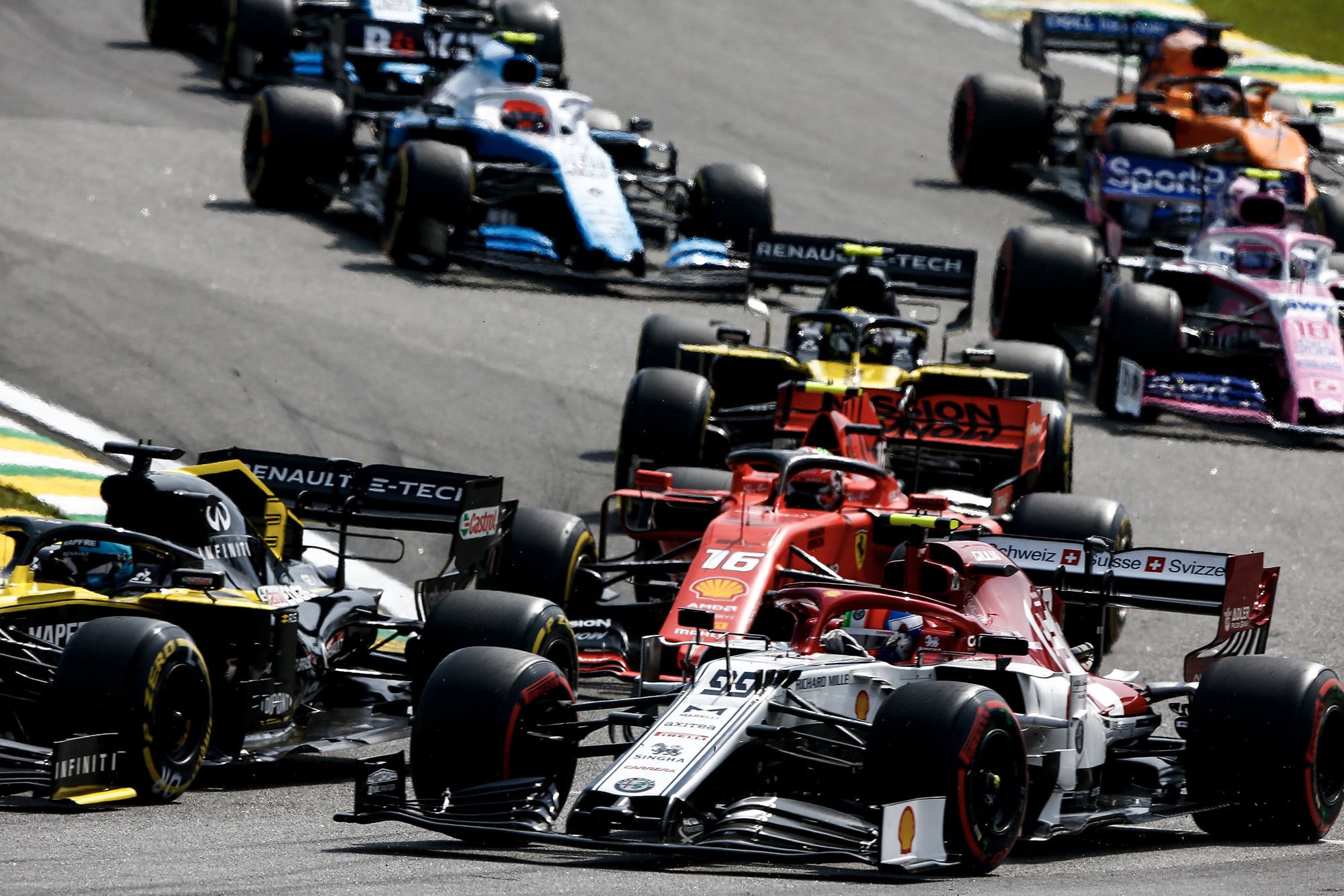
Leclerc in the melee at the start Photo: Motorsport Images
Moves that failed into the Senna Esses would continue onward down the following straight to that other classic passing place of Turn Four, before the descent to the lakes, Grosjean fending Räikkönen off down there for a time but ultimately losing out to the Alfa.
The grid-penalised Leclerc on his medium tyres picked off Giovinazzi, Magnussen, Grosjean, Räikkönen and Gasly within the first 10 laps to be running at the tail of the top team group in sixth. Gasly’s domination of ‘Class B’ was never threatened, with Räikkönen, Grosjean, Giovinazzi and Norris keeping line-astern behind.
After passing Perez, Stroll had put early moves on Ricciardo and Magnussen before the latter two – as the most audacious overtaker and most stubborn defender – predictably collided, at Turn Four. Magnussen got going behind Kvyat and ahead of the in-team Williams battle, initially led by Kubica. The Renault was in for a new nose at the end of the lap and would rejoin well behind the pack. “I take responsibility,” confessed Ricciardo. “It was close. Sometimes you can do that and it works, but sometimes you touch wheels.”
The incident moved up Sainz – who had passed Perez with a great move into Turn Eight – to just behind Stroll and ahead of Hülkenberg, Kvyat, Magnussen, Kubica, Russell and Ricciardo. The Williams pair were lapping around 1sec off the tail of the rest of the field and so were soon reeled-in by Ricciardo.
As early as lap three Hamilton was radioing of Verstappen, “I think he’s going for it,” as he observed how hard Verstappen was pushing. Going into the race Mercedes had been as convinced as anyone else this was going to be a two-stopper but as it observed lower-than-expected degradation rates for Hamilton, the possibility of one-stopping came onto the radar, hence Hamilton was being encouraged not to chase the Red Bull too hard, too soon. This wasn’t, in other words, the sort of race where Mercedes could dictate things by its performance. It was hanging on, hoping there might be a way of out-manoeuvering its rival.
Hamilton however was eager to get going. By the 10th lap, he was a couple of seconds behind but pulling further clear of Vettel whose Ferrari – just as in the Friday long runs – was suffering greater degradation than the Red Bull or Mercedes. Bottas wasn’t happy in this first stint, an understeer balance seeing him falling away even from Vettel, with Albon not far behind. The group weren’t pulling away from ‘Class B’ as quickly as usual and Gasly was enjoying the clear air of heading that group and just ensuring he stayed out of undercut range and looking after his tyres. He was doing an immaculate job.
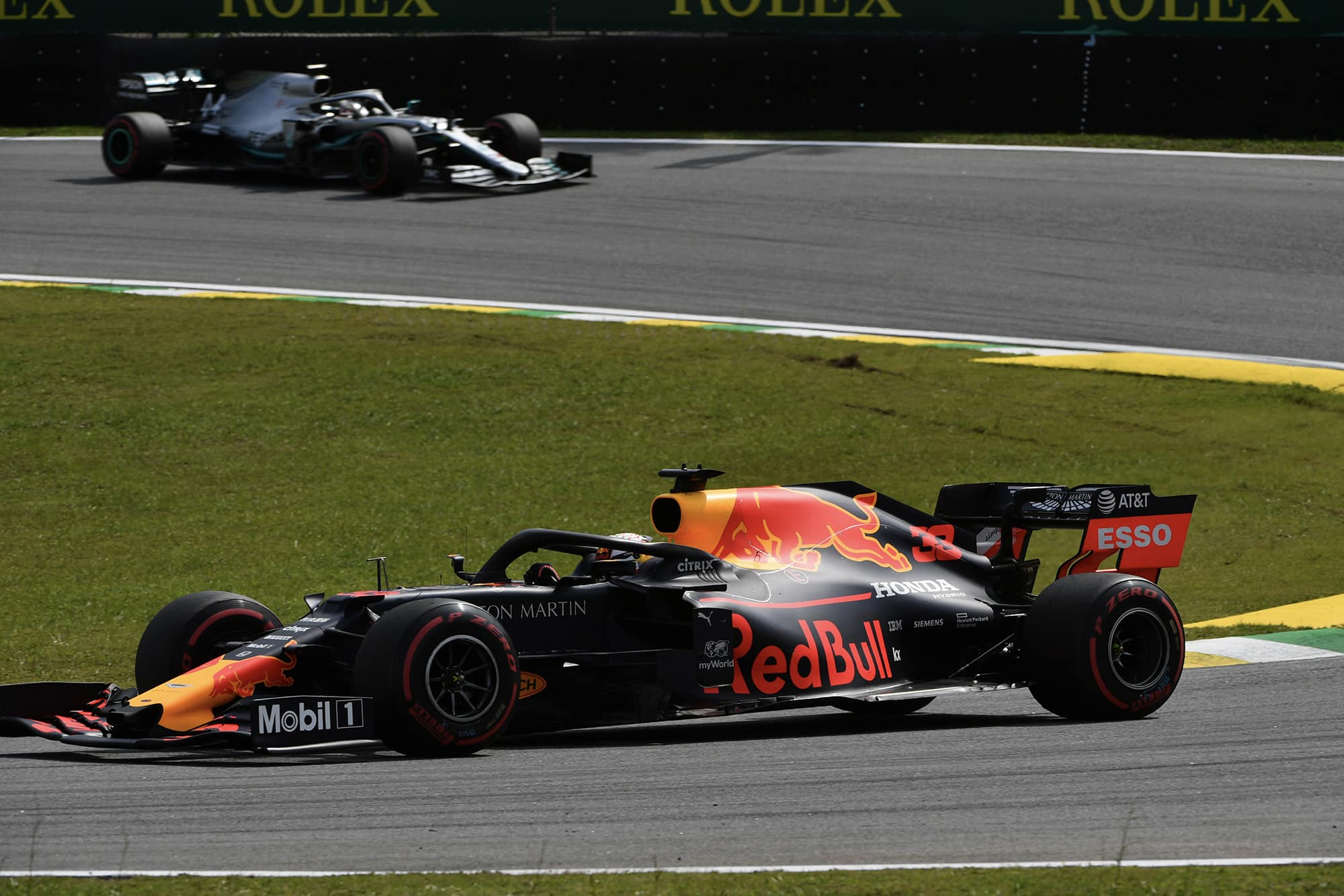
Verstappen had the gap; Hamilton the better tyres Photo: Motorsport Images
It was Gasly that Mercedes was monitoring as it needed Hamilton to get a pit stop’s-worth of gap over him to make an undercut attempt on Verstappen. Hamilton’s earlier caution as Verstappen made his own flying rhythm was beginning to pay off; his tyres were in better shape than the Red Bull’s as the pit stop window opened. “Let’s attack, Bono,” urged Hamilton, clearly keen to have a gloves-off race now there were no title concerns to worry about. They’d let him loose from around the 15th lap and he’d got to within 2sec of the leader by the time he had enough of a gap to drop into. He was keen to pit soon. “Don’t miss this shot,” he urged, knowing he couldn’t stay this close for long.
On the Red Bull pit wall, they felt confident enough of their pace that they didn’t feel the need to anticipate the undercut by pitting first. Two seconds was probably about as close as Hamilton was going to get and he was called in from there to pit at the end of the 20th lap, for another set of softs, thus committing to the two-stop.
“It was a bit of a stretch of an undercut,” acknowledged James Allison. “It was just theoretically within undercut range, and Lewis had to scrape out a fast out-lap to make that work.” This was when Bono had informed his charge of how crucial the out-lap was and received the knowing response. It was a monster of an out-lap, around 1.5sec faster than anyone else managed.
Verstappen was called in for his new softs in response and the Red Bull crew turned him around in under 2sec – clawing back some of what Hamilton had just gained on them. Verstappen set off down the pitlane and just as he reached the end of it, was forced into a virtual emergency stop as Williams released the just-pitted Kubica right into his path (for which he’d later receive a 5sec penalty). It was disastrous timing as the delay allowed Hamilton to flash by on Verstappen’s right as he rejoined the track not yet fully up to speed.
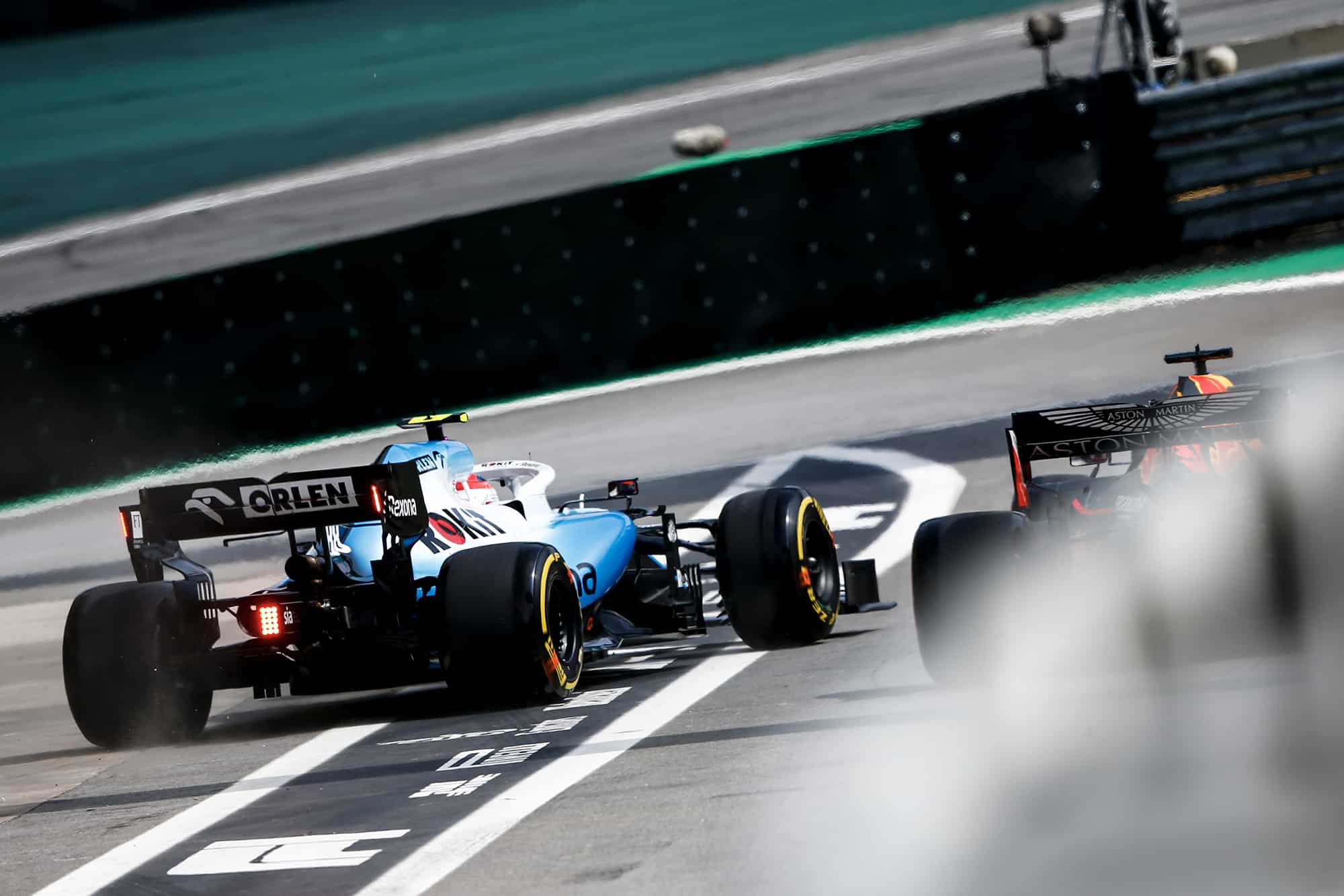
Kubica puts the brakes on Verstappen’s pit exit Photo: Motorsport Images
He was incensed – and set about putting things to rights asap. Up ahead he could see Hamilton was about to encounter the yet-to-pit Leclerc on his old medium tyres. There might be possibility there. That’s what Hamilton was thinking too. If he could just get the Ferrari between him and the furious – and furious-fast – Verstappen, he might have a chance of keeping him behind.
So Hamilton pressed on, deploying his battery for the required extra grunt as he got alongside the Ferrari, and past, around the outside the downhill sweep of Mergulho (Turn 11). But unfortunately for Hamilton, Verstappen took advantage of Leclerc’s checked momentum from being passed to also nail a move – down the inside into Juncao, the left-hander at the bottom of the hill that precedes the long climb back to the top that runs in parallel to the Favelas a few hundred metres – and another world – away.
That decision to keep using the battery – after having just deployed it to the maximum in doing that great out-lap – was in hindsight the critical error that lost Hamilton any slim chance of defeating Verstappen. Had he been able to stabilise the power and retain track position, it’s just possible the slower car may have been able to stay ahead. But by no means certain.
As it was, Hamilton had no battery power left as he crested the hill and burst onto the pit straight. Verstappen had a Honda engine with more power than the Mercedes, DRS and plenty of battery charge. He was consequently over 20mph faster than Hamilton as they crossed the start/finish line, and it was a simple matter to breeze back ahead even before the Senna Esses. The emotional intensity of the fight could be clearly heard as Hamilton complained about not being kept informed about his battery.
Up ahead of Verstappen was his yet-to-pit team-mate Albon who let him through without delay on the infield, with Hamilton then slipstreaming and DRS-ing the second Red Bull to pass into the Senna Esses in forlorn chase of the flying Verstappen.
Vettel hadn’t been able to keep in touch with the lead battle but stayed out a while yet in an out-of-sequence lead. The thinking was to try running long enough to keep the one-stop option open – or at least be on newer tyres than them later in the race if he two-stopped. He came in on lap 25 for a set of mediums. Bottas followed a lap later (just as Verstappen was about to devour him) and Mercedes put him on the rarely-seen hard tyre. If the one-stop did end up working, they reasoned, they would have a greater range than the medium-tyred Vettel. It didn’t work out that way; the hard was not only slow but its performance degraded at least as quickly as the faster mediums.
With Albon already pitted (on lap 24 for a set of mediums), Leclerc was last of the top six to come in, exchanging his mediums for a set of hards on the 29th lap. The first round of stops completed, Verstappen led Hamilton by 2.3sec, with Vettel a further 10sec down but well clear of the well-spaced Bottas, Albon and Leclerc. Vettel was holding a good initial pace on his mediums, hanging onto Verstappen and Hamilton, ensuring they’d have to pass him on track if he one-stopped, but probably not enough that he’d be able to fend them off. It remained to be seen if the tyres’ performance would hang on long enough for that single stop plan.
Behind the top three teams, Gasly’s Toro Rosso remained in command around half-a-lap adrift of Verstappen, still keeping comfortably out of the reach of the Alfas of Raikkonen and Giovinazzi (whose earlier stop had undercut him past Grosjean). Perez’s early stop had bought him places and he was between Giovinazzi and Grosjean but destined to be running out of rubber sooner.
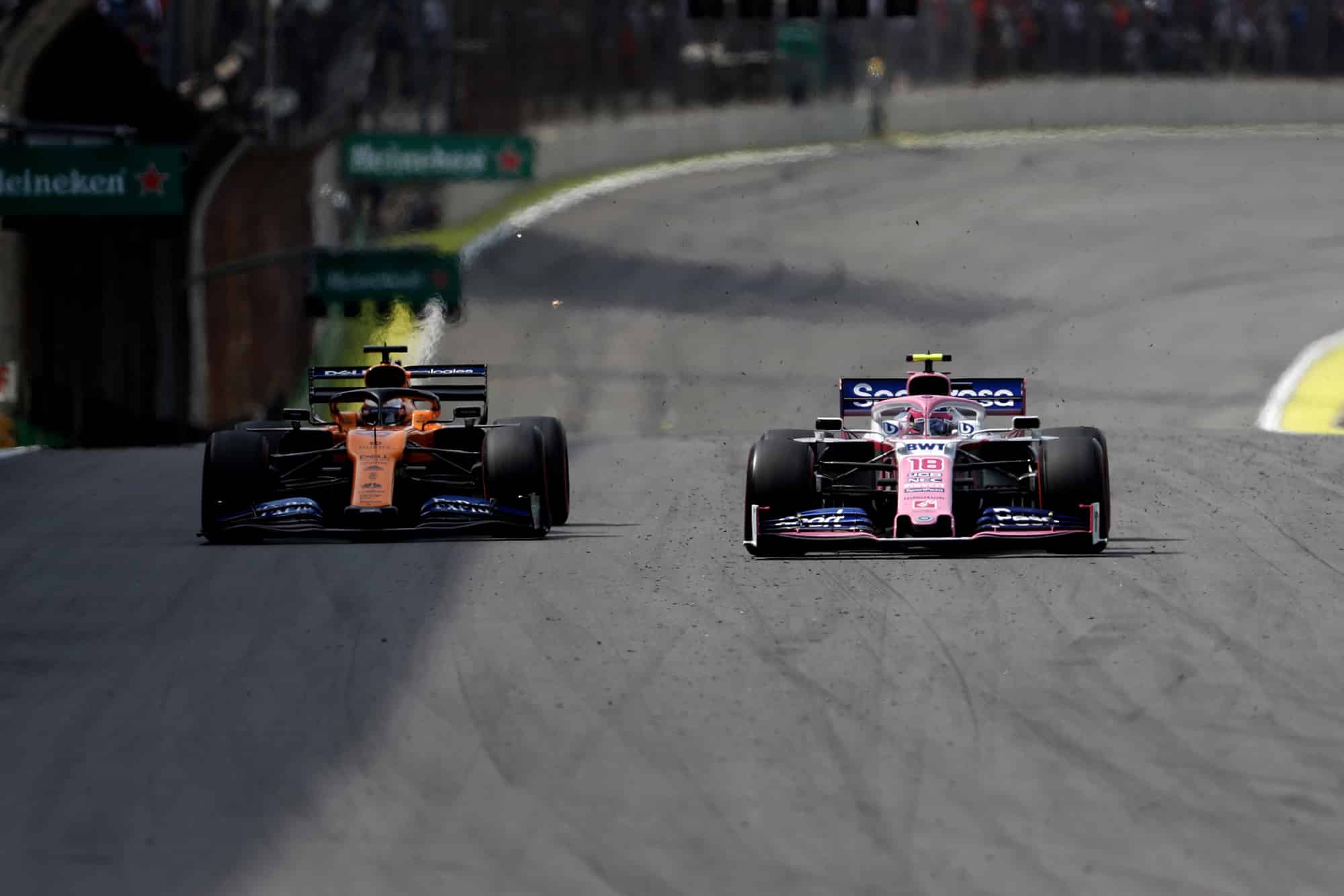
Sainz overtakes Stroll Photo: Motorsport Images
Norris was putting pressure upon Grosjean a couple of seconds ahead of the early-pitting Kvyat who was soon being pushed by Sainz who’d overtaken Stroll on-track and was planning to one-stop. Ricciardo was out of sequence in his recovery drive but would make his set of softs last an age to later emerge ready to fight within this fierce little ‘Class B’ group. Trailing at the back well behind Hulkenberg and Magnussen, Kubica had lost out in the Williams fight to Russell, unable to retain any heat in his front tyres as they wore and falling badly off even his earlier pace.
“I cannot keep up with him,” radioed Hamilton, talking of the flying Verstappen early in the second stint. The champion reckoned he was on the wrong choice of tyre with the softs – but actually he wasn’t. The hards were proving useless on Bottas’ car, so the choice was only between mediums and softs and they’d chosen the latter as they were trying to undercut Verstappen – which the mediums certainly couldn’t have done. He’d get onto the mediums for his final stint, which would be coming soon enough.
Mercedes meanwhile bailed Bottas out of his one-stop after a stint of just 14 laps on the hards. He came in on the 41st of the 71 laps for a set of mediums on which to go to the end. Hamilton pitted from 3sec behind Verstappen on the 43rd lap, with Max duly following on the next lap to cover him off. Yet again, the Red Bull crew turned him around in a superb 1.9sec.
After his promising early stint pace, Vettel’s tyres had dropped off badly and he pitted out of the lead for softs just before he was about to be passed by Verstappen. Red Bull got Albon onto softs a lap later and the order looked to have been set. Hamilton was still gamely keeping the pressure on Verstappen but the Red Bull appeared to have him fully under control. Vettel was probably set for a lonely third under no threat from Bottas who was comfortably clear of Albon who might – or might not – have been caught before the end by Leclerc.
But the yet-to-pit Leclerc was holding off the faster newer-tyred Bottas who was becoming frustrated: “They are so fast on the straight.” He kept pushing but the team had just become alerted to a sudden increase in oil consumption when the smoke began trailing from the exhaust and moments later it cut out entirely. This was lap 52. Bottas coasted it to a safe place on the grass before Turn Four and double-yellows were waved there as Bottas and the marshals initially struggled to re-attach the steering wheel. Subsequently there was further delay, as the car’s floor had dug into the uneven earth there, making it impossible to push to the other side of the barriers. A crane would be required. As soon as the crane is used it now automatically triggers a full safety car. This came two laps after Bottas stopped.
Opportunities and dilemmas up and down the pitlane. “Do the opposite to Verstappen,” Hamilton was told. But what would Verstappen do? It is a brave strategy call to surrender the lead. What did Red Bull’s strategist Hannah Schmitz prefer: to have Verstappen on old mediums in the lead at the restart but with Lewis Hamilton on fresh softs breathing down his neck? Or, to be on new softs in second place breathing down the neck of Hamilton on old mediums? She chose to surrender the lead, with a confidence borne of their superior pace, the passing-friendly layout of Interlagos – and Max Verstappen. So Hamilton stayed out leading on 12-lap old mediums, Verstappen rejoined on new softs and positioned himself on Hamilton’s tail ready for the restart…
The race was about to go wonderfully high-octane.
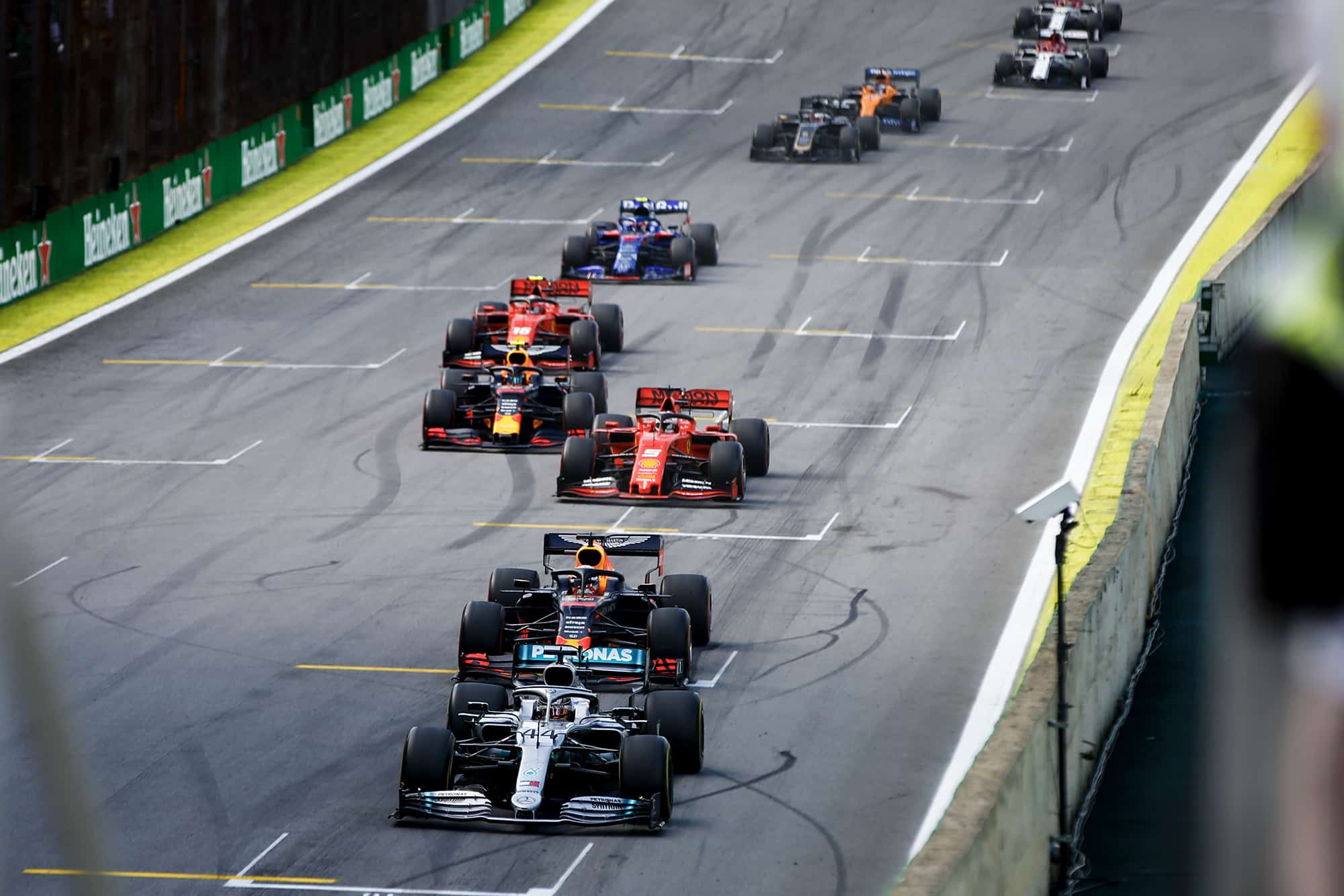
Hamilton leads — briefly — at the first restart Photo: Motorsport Images
Leclerc had made his second stop under the safety car to get onto new softs and with his previous deficit all wiped away by the queue behind the Mercedes GT, he lined himself up on the tail of Albon who was the Red Bull meat in a Ferrari sandwich as he positioned himself right behind third-place Vettel. “I’m a sitting duck,” radioed Hamilton on his old tyres as he clocked Verstappen’s new softs.
The safety car came in at the end of the 59th lap. At this point Hamilton made a tactical error in the positioning of his car as he crawled along, allowing the safety car to go, with racing not starting until the start/finish line but when to sprint away before then entirely at Hamilton’s discretion. At Turn 11 he allowed Verstappen to get on the advantageous side for when they would climb the hill. The pack came up there at parking speed offset in the correct order but almost two-abreast. As Hamilton put the hammer down, Verstappen reacted well and – on the better line – was able to immediately retake the lead around the outside into the Esses and Mrs Schmitz doubtless breathed a sigh of relief.
Hamilton didn’t lose the race through the misplacement – he’d have been passed anyway. The Red Bull was just faster. Faster on the straights, more power up the hill, faster through the corners with a big tyre advantage. Verstappen was coming through anyway. In hindsight, the only way Hamilton might have won would have been if Verstappen had stayed out, enabling Hamilton to get onto new softs. Red Bull had called it spot-on.
As Verstappen was passing Hamilton, Albon was doing the same to Vettel, with a brilliantly assertive move to take third. It was crazy-manic everywhere now, as the Ferraris diced hard behind Albon. Hamilton tried for Verstappen’s outside at Turn Four but Max had it covered. Vettel was trying to retaliate on Albon up the hill to Ferradura. Further back, Gasly was nibbling at the back of Leclerc while Grosjean had been mugged out of the place just behind Gasly, with the cold-tyred Haas devoured by Sainz (who had made only one stop) and the Alfas (which had made second stops before the safety car). Grosjean would drop further as he suffered an ERS-K problem and Ricciardo, Norris, Perez and Kvyat would all steam by. This was a remarkable recovery from Ricciardo who’d been last by a long way after his early collision.
Albon was looking at Hamilton’s second place now and on the 63rd lap took a DRS run on it up to Turn Four. Hamilton held him off and a lap later Vettel was all over the back of Albon once more, trying to reclaim his place, the Ferrari getting ahead on the outside approach to the Senna Esses, but Albon aggressively claiming the first apex and forcing Vettel out wide. As Vettel re-marshalled his battery resources, so Leclerc got a run on him on the next lap and – from a long way back – made a very aggressive move (especially for a team-mate) into the Esses to take fourth place. But Vettel was coming back at him. With second in the constructors championship secured, the Ferrari drivers had been told they were free to race. “I left him space around the outside of turn three,” related Leclerc later, “and he took it. Then down the straight he started to squeeze me a little bit to the inside…”
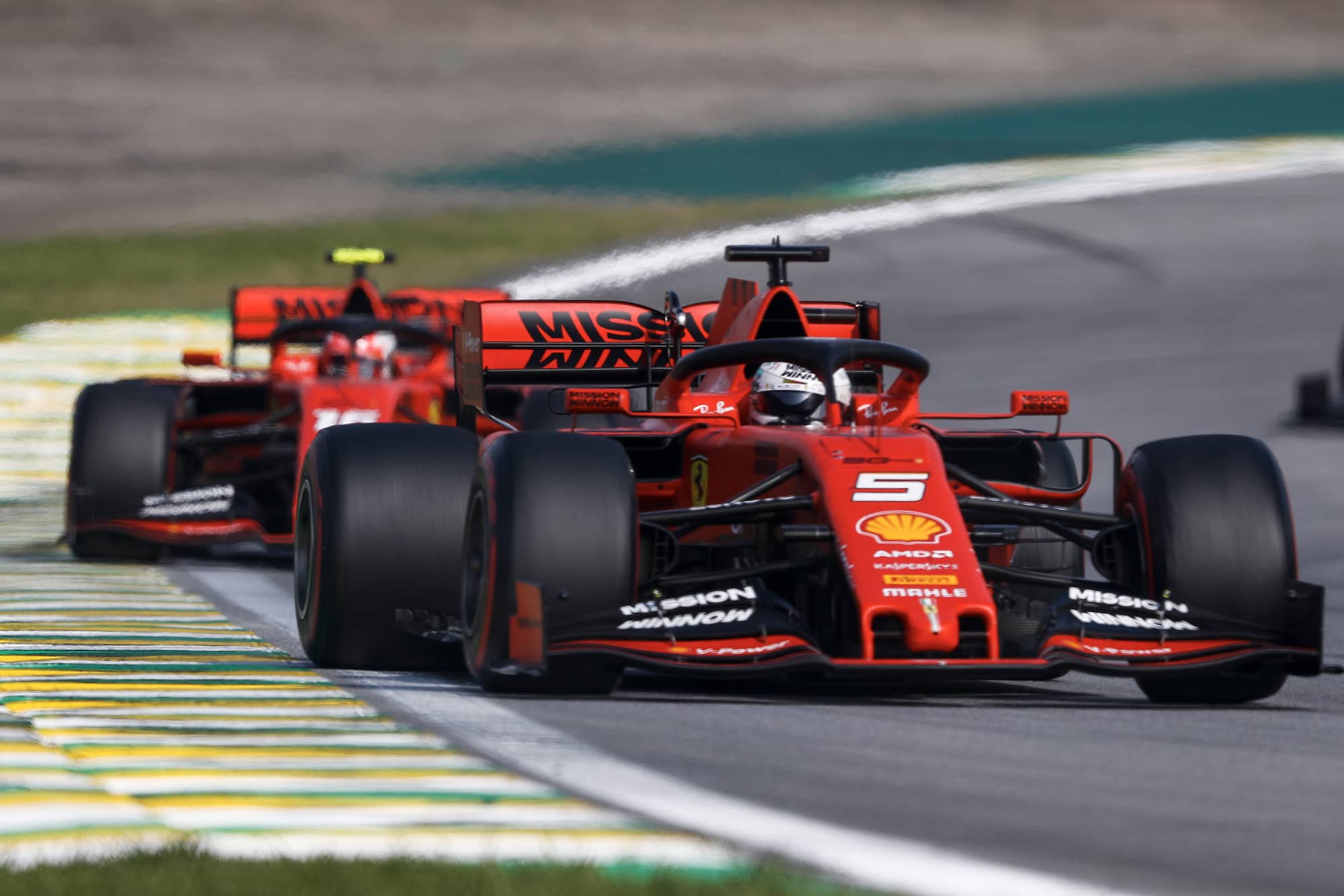
Leclerc looms just ahead of Ferrari implosion Photo: Motorsport Images
That is indeed what Vettel did and it was rather reminiscent of Istanbul 2010. Leclerc remained arrow-straight as Vettel, with more momentum from the outside line of Three, tried to dummy himself the space to take the outside line for Turn Four. As he passed, his left-rear glanced Leclerc’s right-front which punctured instantly. Vettel’s tyre let go a second or so later, destroying the floor as it did so. Both Ferraris were out, there was carbon fibre debris between Turns Four and Five – and Stroll went over some of it, destroying the Racing Point’s front suspension. Cue another safety car.
At this point Mercedes made what James Allison later described as, ‘Something plain dumb. Not having had the shiniest of races up to that point, we thought we were exchanging a place for fresh rubber with enough laps left to get that place back promptly and have a go for the lead. That was just a) factually incorrect because we were exchanging two places; we hadn’t factored Gasly and b) with the amount of debris on the track there was just a lot more laps taken up by safety car than we had anticipated, that was your rookie error of a not quite quick enough car on the day and trying to stretch too far for a victory that wasn’t on and we just made a mistake.”
Hamilton’s insistence that his tyres were finished coloured the team to ask him if he wanted to come in. They were just beginning to say, ‘But we’d prefer you to stay out,’ when Hamilton was already in the pitlane. On went a set of softs – and out he came, now fourth in the safety car queue, behind Gasly. Honda cars were now running 1-2-3 and it looked a very realistic possibility that the race would finish under the safety car in that order. But racing resumed with two laps to go – two more crazy laps.
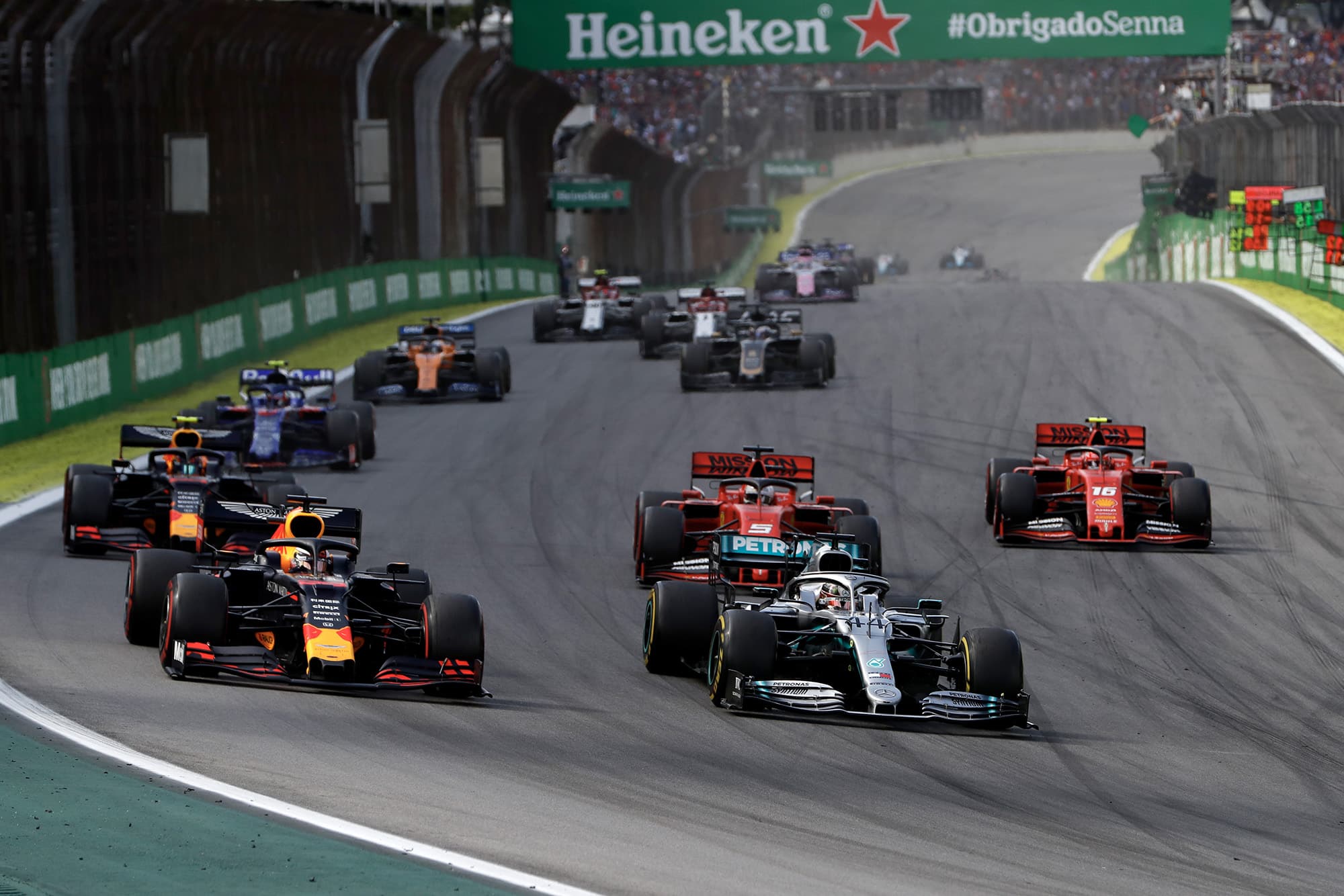
Honda in a 1-2-3 position at the second restart Photo: Motorsport Images
Verstappen, Albon and Gasly didn’t interfere with each other upon the restart, but Hamilton was able to pounce immediately upon Gasly to set chase for Albon, with the idea in his mind that if he could pass him immediately, he might just get to use his new tyre grip to steal the win from Verstappen at the last gasp. With just over a lap to go Hamilton was tailing Albon as they headed into the hairpin of Turn 10. Albon left the door open. He thought if he just braked late, there’d be no opportunity for Hamilton. But the latter saw the gap and launched his car into it. He was only partly alongside and, unsighted, Albon turned in. They touched, Albon spun and, as Hamilton lost momentum, he was repassed by Gasly. “I massively apologise to Albon,” said Hamilton later. “I went for a move… the gap was kind of there, but obviously it closed right at the end and completely my fault.”
Verstappen had by now sprinted far clear for his third victory of the year. Coming up the hill on the final lap Hamilton was desperately trying to hook himself inside the Toro Rosso, but that Honda motor just kept pumping out the good stuff as Gasly stayed foot nailed to the floor. Wheels almost touching at massive speed, the Toro Rosso remained ahead to the flag, with Hamilton third across the line and penalised 5sec for the Albon incident, dropping him down to an official seventh.
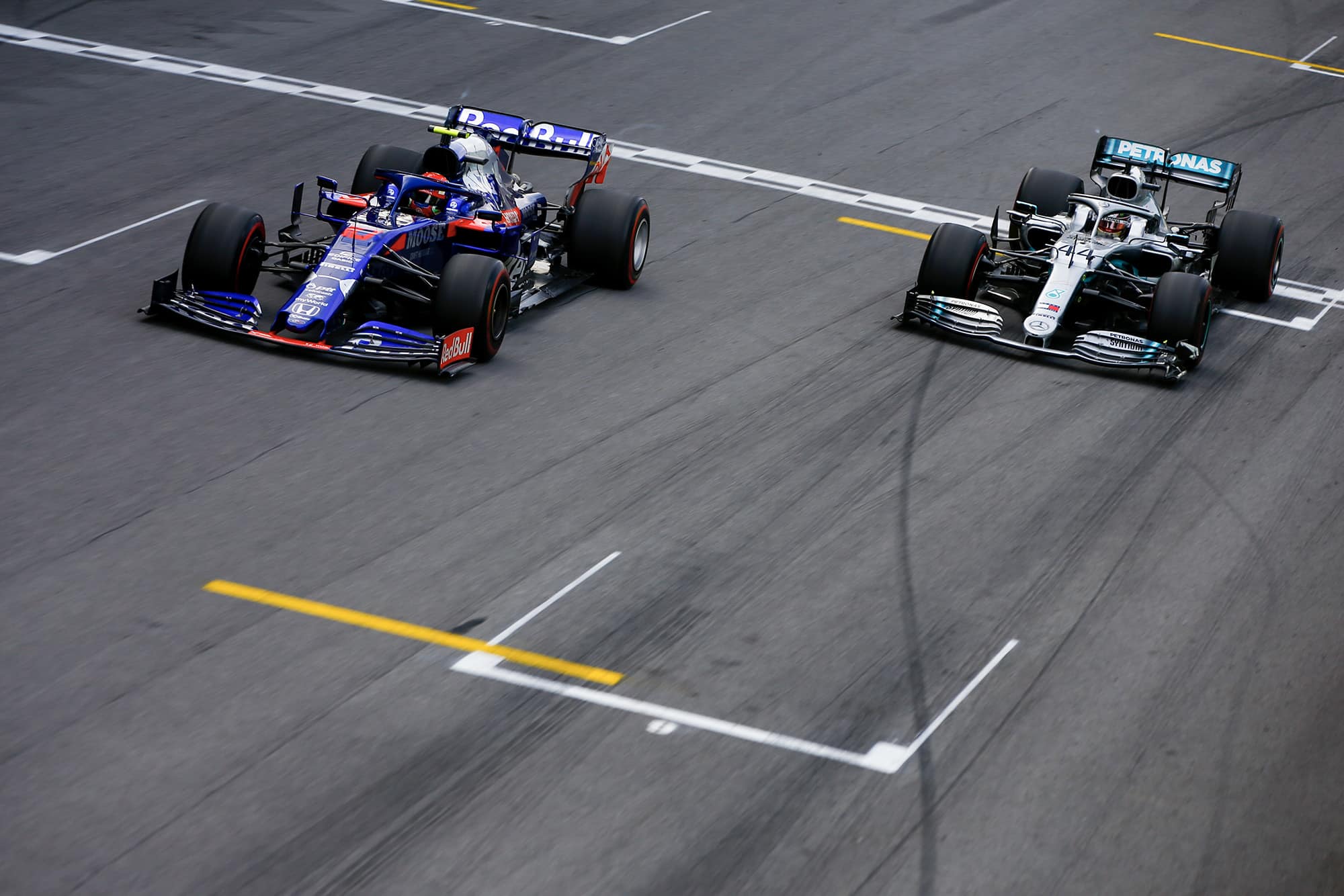
Hamilton and Gasly battle to the line Photo: Motorsport Images
All of which put Sainz – who had done a remarkable job on ancient tyres to fend off the Alfas on the restarts – third from Räikkönen, Giovinazzi and Ricciardo. Norris, Perez and Kvyat took the final points behind Hamilton. Grosjean’s disastrously diving tyre-temperatures saw him mugged further by Magnussen, Hülkenberg and Russell. Hulk dropped places after a 5sec penalty for passing before the start/finish on one of the restarts.
Which was this race’s biggest story? The Honda 1-2? Gasly’s resurrection? The Ferrari calamity? Regardless, Max Verstappen cast a thread of total control and dominance over the entire weekend.

Twelve years after Mercedes blew the field apart, we chart how F1 finally closed the gaps - and why the 2026 reset could reopen them

Every Tuesday in 2025, Matt Bishop delivered his idiosyncratic and meticulously researched stories to Motor Sport readers. Here are five of the highlights

Blazing sunshine over a mesmerising, daunting circuit with Murray Walker calling the action. Has there ever been a more glorious start to the F1 season?

From Japan to Mexico, Surfers Paradise and Milwaukee, we chart the best onboard racing shots caught in 2025